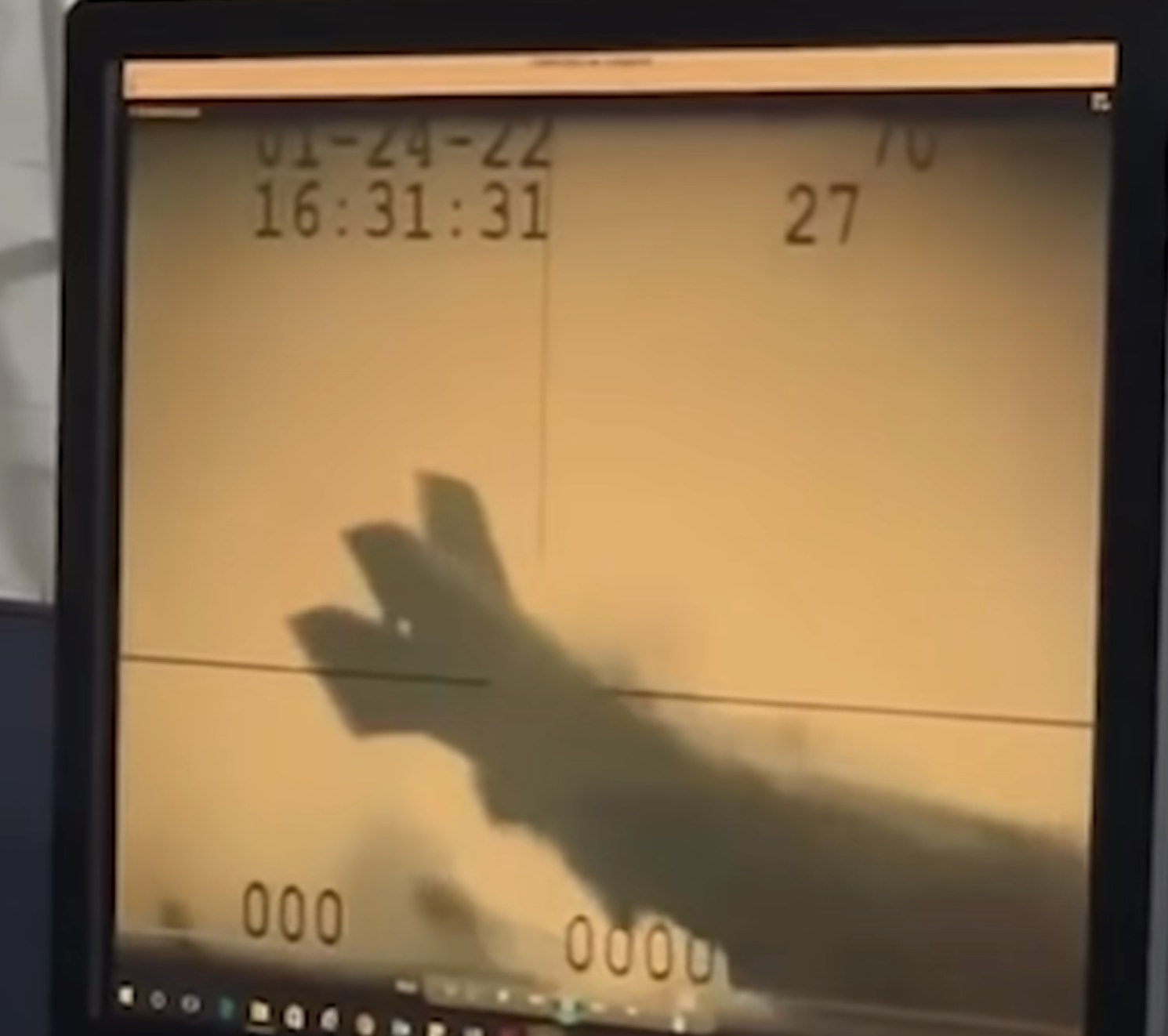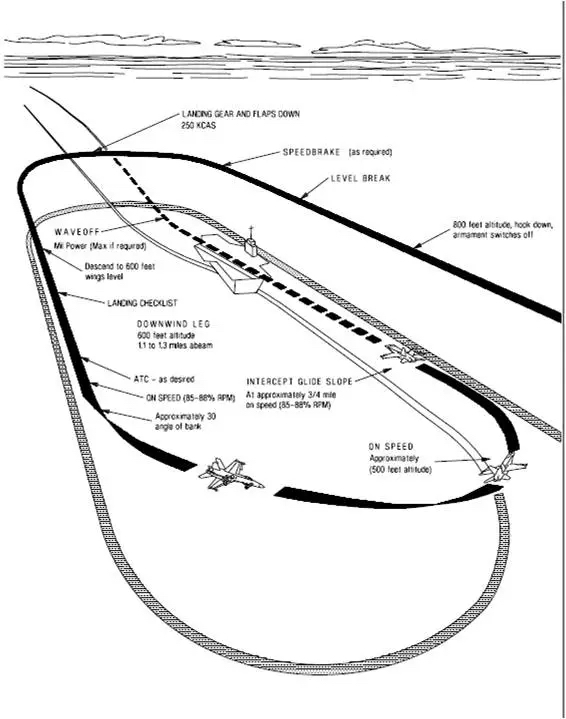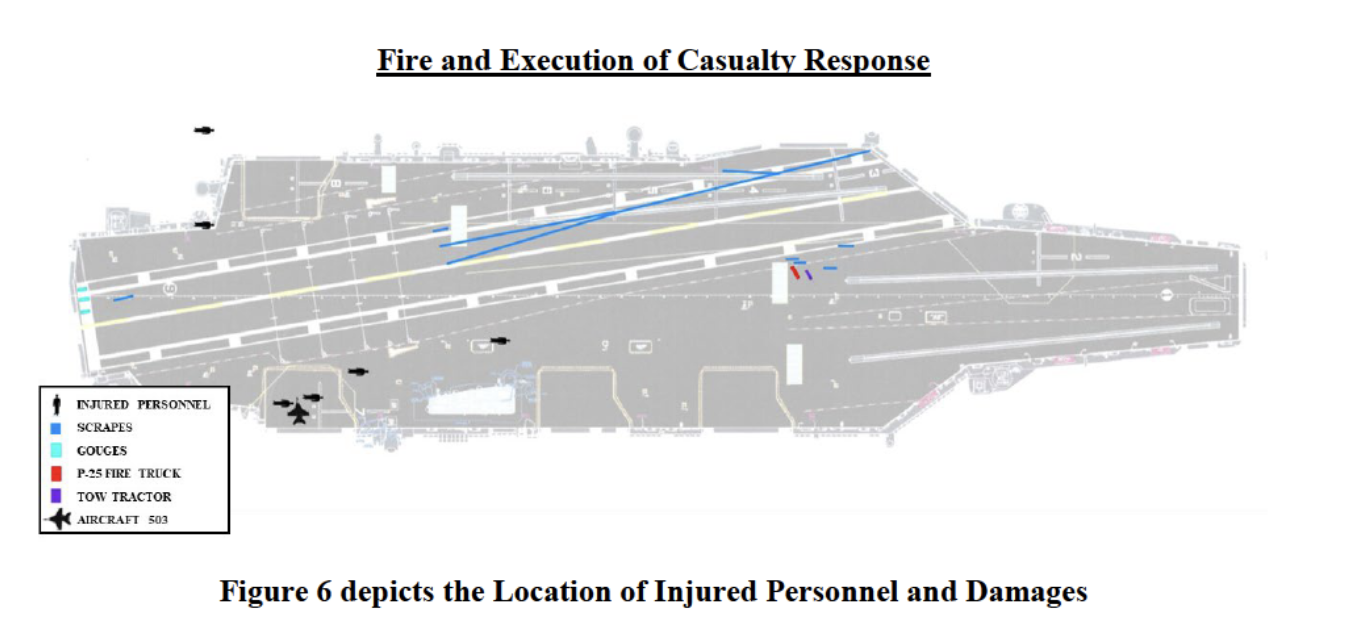
This post has been modified to clarify the recommendations from the investigators.
A 2022 ramp strike aboard the carrier USS Carl Vinson (CVN-70) that injured six sailors and resulted in the loss of an F-35C Lighting II Joint Strike Fighter was due to a mistake by the fighter pilot during landing, an investigation into the Jan. 24, 2022 incident determined.
The junior officer had performed a specialized landing approach to Vinson for the first time, but he did not realize a built-in aid that helped control the plane’s power during landing was switched off. The F-35C made an underpowered approach to the carrier, according to the investigation obtained by USNI News.
By the time the pilot realized his aircraft was underpowered, there wasn’t enough time to stop the aircraft’s nose from striking the back of the flight deck, collapsing the F-35Cs landing gear. The momentum carried the fighter, assigned to the “Argonauts” of Strike Fighter Squadron (VFA) 147, across the Vinson’s deck and into the South China Sea. Flying debris injured five sailors on the deck. The pilot was hurt ejecting from the fighter, according to the investigation.
“This mishap was the result of pilot error,” wrote U.S. 7th Fleet commander Vice Adm. Karl Thomas in his June 3rd endorsement.
“The mishap pilot (MP) attempted an expedited recovery breaking overhead the carrier, an approved and common maneuver, but the MP had never performed this maneuver before, and it reduced the amount of time to configure the aircraft and conduct landing checks,” the report said. “As a result of the compressed timeline and the MP’s lack of familiarity with the maneuver, the MP lost situational awareness and failed to complete his landing checklist. Specifically, the MP remained in manual mode when he should have been (and thought he was) in an automated command mode designed to reduce pilot workload during landings.”
The ramp strike followed a routine mission of just under four hours for the junior officer pilot and his wingman.
The investigation found that the F-35C pilot, who was on his first deployment, had 650.3 total flight hours with 370.7 in the F-35C, was well rested, mentally fit and among the top performing junior officers in Carrier Air Wing 2. The fighter, designated JASON 406, had a degraded electronic warfare system but was otherwise mission capable. The sky was mostly cloudless, winds were 15 knots straight down the carrier deck and the seas were low – with two-to-four-foot waves.
According to the investigation, the pilot wanted to attempt a landing maneuver popularly known as a Sierra Hotel or “Shit Hot” break for the first time.

The Sierra Hotel Break is a maneuver in which “an aircraft uses G-forces to decelerate over the course of a 360-degree turn, dropping the landing gear when the aircraft is below landing gear transition speed. When breaking aft of the ship or overhead the ship, a pilot has a reduced amount of time to configure the aircraft and conduct landing checks,” reads the investigation.
The pilot started the first turn of the break at the rear of the carrier just over the landing signal officer platform.
“He did not want to be too fast during the break and he remembered his airspeed being 370-390 knots as he initiated a break over the LSO platform. He called ‘Burner’ on the auxiliary radio, informing his wingman that he was selecting afterburner, and then initiated his break, deselecting afterburner after a few seconds,” reads the investigation.
After the turn, the pilot didn’t engage the two landing assist tools on the fighter, the Approach Power Compensation Mode (APC) and the Delta Flight Path (DFP), which automate some of the pilot’s necessary tasks for landing on an aircraft carrier. When activated, DFP automatically adjusts the throttle to keep the aircraft on correct glide scope to land on a carrier, while the APC maintains the fighter’s angle of attack.

JASON 406 entered the “groove,” or the final approach to the carrier, and was moving too slowly.
“The [pilot] realized that the jet was extremely underpowered as the jet became slow and continued to descend (settle),” the investigation continued. “At this moment, [the pilot] manually pushed the throttle to military power and then went to maximum afterburner once he realized that the airplane was in a perilous state, failing to climb,.”
Six seconds later, the LSO told the pilot the speed was too low. A second later the LSO told the pilot to wave off and hit the afterburners.
Data recovered from the F-35C after the crash showed that after the turn the F-135 engine on the aircraft shifted to flight idle – the minimum throttle position for the engine – and remained there until the pilot attempted to accelerate two seconds before hitting the ramp on Vinson.
Timeline of Ramp Strike on Jan. 24, 2022:
- 1630:37: [Pilot] initiates the carrier break at the stern of CVN 70.
- 1631:04: [Pilot] lowers the landing gear.
- 1631:20: [JASON 406] enters the groove.
- 1631:25: Backup LSO gives a “Right for lineup” call.
- 1631:26: Primary LSO gives a “Little power” call.
- 1631:27: CAG Paddles gives a “Powe– Waveoff, Waveoff, Burner, Burner,
Burner… Burner” call. The word “power” is not completed by CAG Paddles before
starting the “Waveoff…” sequence of calls. - 1631:31.4: [JASON 406] impacts the ramp of CVN 70 just forward of the MA main landing gear, shearing the main landing gear, bouncing the tail of the MA into the air with a left-wing-down, nose-down component.
Then the nose of JASON 406 “impact[ed] the ramp of CVN-70 just forward of the MA main landing gear, shearing the main landing gear, bouncing the tail of the MA into the air,” reads the report.
An anti-air missile bracket on JASON 406 caught on the arresting wire and started a counter-clockwise spin on the fighter. It slid on its belly down the flight deck at nearly 95 miles per hour before falling off.
According to the investigation, the snag and the subsequent rotation was a lucky break for Vinson and its crew.
“This likely kept the MA fuselage wreckage from impacting other personnel, ground equipment and aircraft parked on the fourth row of CVN-70’s bow,” reads the report.
As JASON 406 hurtled down the deck, flying debris from the crash injured the sailors. In addition, debris from the crash damaged an EA-18G Growler on the deck of Vinson, causing more than $2.5 million in damage to the aircraft. The crash also caused an estimated $120,000 of damage by gouging the flight deck, according to the report.
Following the crash, the crew quickly began damage control procedures and was able to quickly clear the flight deck, USNI News previously reported.
“Within 30 to 45 minutes, we were ready to receive aircraft,” a service official told USNI News last year. “The USS Lincoln was nearby, so they went and got a drink of gas at the Lincoln and then came back to us that same night.”
The Navy recovered JASON 406 a month later using unmanned vehicles deployed from the commercial platform DSCV Picasso.
Ultimately, investigators determined that “pilot error was the cause of the mishap. However, the error was not conducted in a reckless manner nor with malicious intent,” reads the report.
A Navy spokesman told USNI News that, due to the crash, the pilot has been removed from flight status but is still in the service.
Additionally, investigators recommended that F-35C pilots to always use Approach Power Compensation Mode (APC)/Delta Flight Path (DFP) throttle assists and that heads-up displays include additional audible indicators showing when flight aids are activated. The investigation board did not recommend eliminating the Sierra Hotel breaks in the future.





